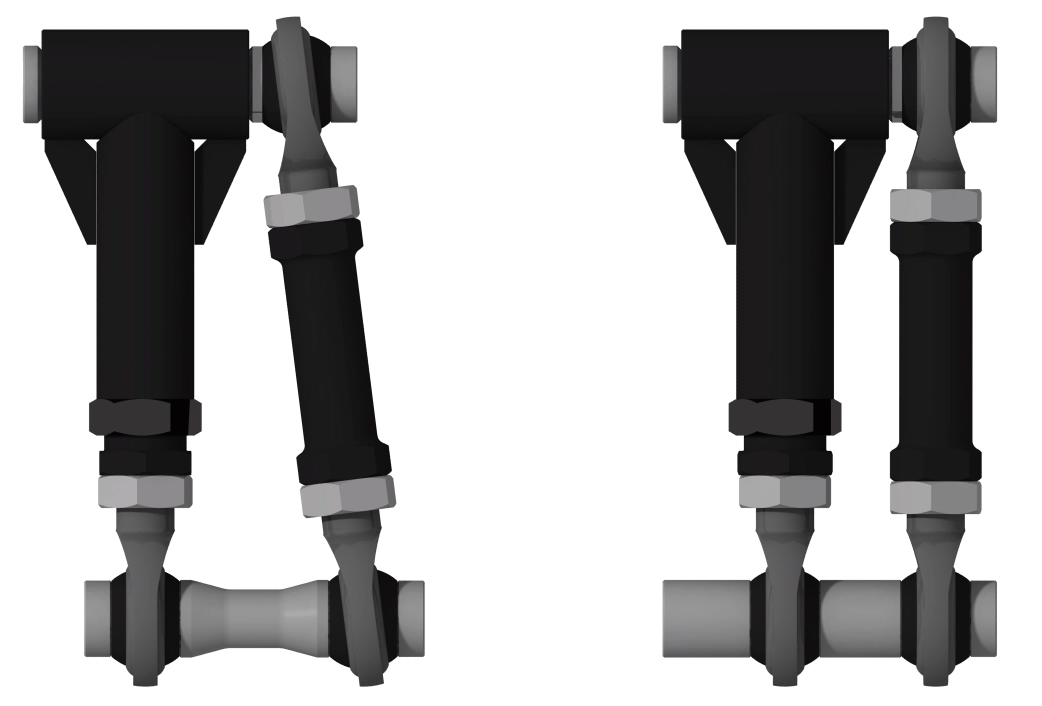
Lowering a car seems to produce an endless amount of problem-solving. As the suspension geometry needs correcting when lowering the ride height, so does the length of the drivetrain half-shafts (AKA axles or CV’s). Their length is designed for OEM ride height with OEM specified wheel alignment. If the car is lowered and suspension alignment adjusted with aftermarket suspension arms the drive shaft is pulled out of its normal position and on a low car will break the axle housings.

The OEM half-shaft assembly is designed for a good range of wheel travel and has no issues with factory ride height and wheel alignment. A simple three bearing system called a spider assembly is used at the ends of the axle shafts that provides sufficient strength and misalignment at low cost. The axle bearing housings feature plastic caps inside to avoid metal-to-metal contact. Final drive side housing also has a spring inside it to locate the axle shaft without play.
Even at low ride height the axle is still in correct position. As illustrated in images 2 & 3 the axle position is still correct relative to the snap ring in the outer axle housing without risk of spider assembly being pulled out of the housing.

Image 2 - Axle position at OEM ride height

Image 3 - Axle position at 50mm lowered ride height

Image 4 - Axle position at 50mm lowered ride height + dual caliper bracket
Negative camber values help to keep the spider assembly in correct position, but problems start when the control arms are extended for corrected wheel alignment or tyre clearance on a lowered car
As the control arms are extended the axle is pulled further out from the wheel bearing side housing as seen in image 4. There is now a high risk for the suspension travel to further pull the spider assembly out of the axle housing. During cornering and accelerating the suspension is compressed and if a bump is hit, it is very likely to break axle’s outer housing as the spider assembly will come out of it.

Image 5 - Axle position at 50mm lowered ride height and corrected camber

Image 6 – broken axle on final drive side
2. SOLUTIONS

There are some other solutions for the axle length issue on lowered cars, which are:
- Raised rear differential housing within the subframe
- Suitable wheel alignment - more negative camber or shorter lower control arm
- Longer axles
Raising the height of differential in the rear suspension subframe modification allows for a reduced axle angle and improved ground clearance.
Optimised suspension geometry for positioning the axle requires maintaining OEM link lengths for the upper arms. Camber can be decreased via aftermarket lower control arm that can be adjusted shorter than the OEM control arm. GKtech rear lower control arms allow for shorter length, but shortening it degrades performance and is only recommended if maximum performance is not the goal. The reason why suspension geometry is compromised with a shorter lower control arm is the steepness of the roll center height migration and camber gain curves.
Longer axles can be used from GT-R skylines and 350z and 300ZX twin turbo models. There are also aftermarket axles available in different lengths and strengths. They are quite expensive compared to previously mentioned options and should be done if actual strength of the axles is surpassed or higher misalignment is required.

3. OUR SOLUTION - AXLE SPACERS
The GKtech axle spacers were developed to negate the problems of blown axles on low cars with extended suspension arms. Thicknesses of 5, 10 and 15mm were chosen to be produced based on test fittings.
5mm is recommended for cars that have been lowered about 1”/25mm. 10mm axle spacers should be used on cars that have been lowered about 2”/50mm. 15mm version is for cars that run low ride height with extended lower control arms.
It is very important to choose correct thickness for the application as if the spacer is too thick, the axle will also bind and not allow the wheel to droop and stay hanging in the air, causing wear on the plastic caps inside the axle housings.
A simple way to find correct spacer thickness is to unbolt the final drive flange from the axle housing and pushing the axle in as far as possible at static ride height and dividing maximum distance between the flanges by two and selecting the closest suitable spacer. Nissan half shaft lengths are not equal and if a-symmetric wheel alignment is used then it might be required to install different thickness spacers on either side of the rear differential housing.
4. AXLE SPACER DEVELOPMENT
The axle housing spacing design allows for installing the spacer without changing the OEM mounting hardware that was the main issue as custom bolts would have driven the cost of the product too high for the end user.
The spacer is held in place by the shaft of the axle and to ensure noise and vibration free operation the spacer is placed between the bases of the wheel bearing and axle housing, axial play is removed by the collar that slips into the wheel bearing.
4.1 OUR DESIGN
They were designed in CAD based on measurements done on the OEM components, which were also modeled for more convenient work flow. The edges of the outside diameter has reduced diameter on the sides to help removal during servicing.
The thicknesses are 5, 10 and 15mm as this provides enough spacing for most applications. 10 and 15mm spacers require thread locking on the driveshaft nut with high strength compound or safety wiring. 15mm is the maximum thickness that can be safely used with OEM axle nut and washer combination.
Strength of the spline connection between the bearing hub and axle housing is compromised by a minimal amount and it is much more likely to break the axle housings due to the torque output of the engine.
The new spacers are made from lightweight aluminium. The 15mm is heaviest at 178g, followed by 10mm at 116g and 5mm being lightest at 54g, putting minimal effect on unsprung mass and rotational inertia.

Image 12 - 15mm Axle housing spacer shown in red
4.2 RAPID PROTOTYPING
Rapid prototyping was done to reduce project development time and allow for fast adjustments to be made on the design if the fitment was not 100% correct. In house 3D printer was used to produce the prototypes via FDM type printing that produces PLA plastic parts.
S-chassis version of the axle hub spacers did not work with GT-R model axles and specific versions were designed. The GT-R has a 3mm larger diameter splined shaft and very different housing all together. Same thicknesses were designed for GT-R axles as for 2WD Nissan axles.

Image 13 - GT-R axle modelled based on measurements and photos

Image 14 - GT-R version axle spacer in 3D printed form
4.3 PRE-PRODUCTION TEST FITTING
Rapid prototyping allowed locking the design down for first series of prototypes to be machined. The machined part was produced from bar stock 6061-T6 aluminium and hard anodized for wear resistances and commercial appeal.
The product was then test fitted and track tested to confirm that it performs as expected without failure.

Image 15 - S14 wheel hub side test fitting
5. AXLE SPACERS FEATURES AND BENEFITS
The production version of the axle housing spacer has the following features:
1) Reduced risk of axle housing damage on low cars with extended suspension links
2) Light and durable 6061-T6 aluminium for minimally increased rotating mass
3) Accurate CAD design for easy installation and removal
4) Large diameter to prevent dust entering bearings
5) Grooves for prying them off during servicing
6) CNC machined high quality fitment
7) Durable and aesthetic hard anodized external finish
8) Compatible versions for Nissan R,S and Z chassis and other RWD Nissans
9) Easy to install

Image 16 - S chassis axle housing spacers
6. CONCLUSION
In conclusion the axle spacer has evolved into a fully functional product with zero faults and minimal draw backs. The only drawback of the axle spacer is the reduced spline contact area, but thus far there have been no damaged axle or wheel hub splines on cars where OEM axles are still durable enough.
They are relatively easy to install, depending on how seized the axle nut may be. 36mm socket is used for S chassis versions and impact gun is recommended for removing them. The simplest method for installing them is the removal of the axle from the differential carrier flange and then removing it from the car, slipping on the spacer and repeating the reverse order of disassembly. Applying copper grease on the mounting surfaces is suggested to make removal easier as it avoids sticking between steel and aluminium.
All in all this a very cost effective method of improving drivetrain reliability on lowered cars with extended arms for corrected suspension geometry. Cars with drop knuckles tend to have even longer arms for more performance and they definitely benefit from axle spacers if OEM axles are used.

Image 17 - Nut tightening torque
USA store product link - https://us.gktech.com/v2-axle-spacers-5mm-10mm-or-15mm
AUS store product link - https://au.gktech.com/v2-axle-spacers-5mm-10mm-or-15mm
JPN store product link - https://jp.gktech.com/v2-axle-spacers-5mm-10mm-or-15mm

